#project contemporary artspace
Text
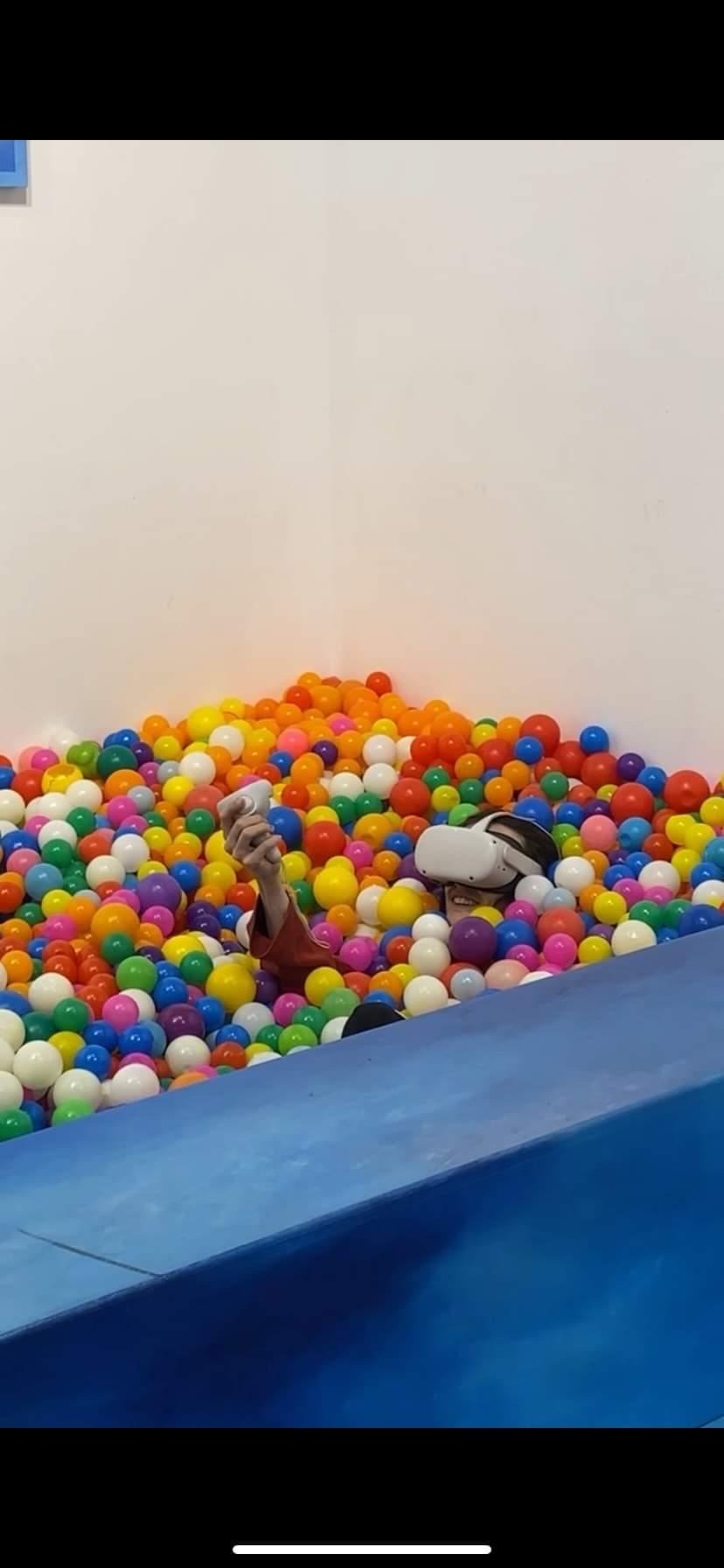
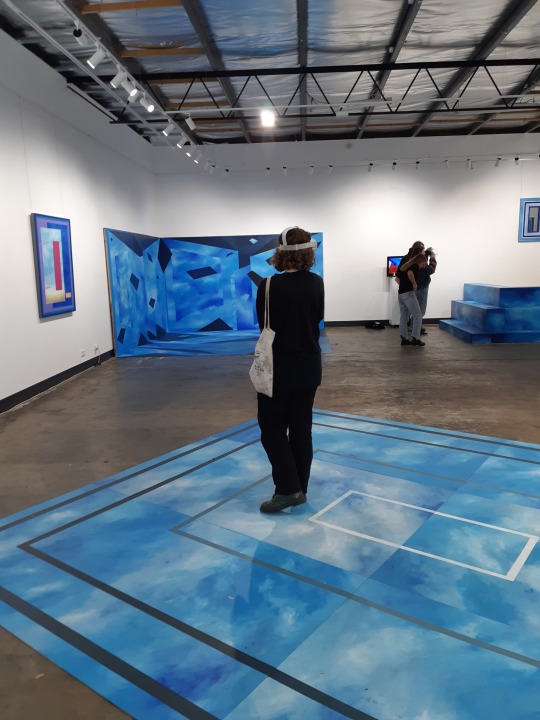
DJ Breda x Brennan Hatton “Marco Polo” exhibition Sept ‘22
#art#dharawal#wollongong#Daniel Breda#DJ Breda#Brennan Hatton#art exhibition#marco polo#artist#independent#aus#australia#vr#virtual reality art#vr art#virtual reality#goth#treasuretroves#attended#project contemporary artspace
0 notes
Note
Hi, I hope this isn't intrusive (my apologies if it is, feel free to ignore), I had a question regarding your art. What made you decide to be an artist? Was there a particular gut feeling towards it, or was it something you happened to stumble on? I live on Treaty 7 land, and I am considering switching my major to art. But I'm worried following my passion wouldn't be worthwhile regarding employment in this particular area. Thank you for your time!
not intrusive at all! like a lot of artists i’ve always been interested in art since i was a kid, and i didn’t have the best grades in highschool but i somehow managed to get into art school in treaty 6 where i got a diploma. initially i was mainly interested in drawing and tattooing but when i started taking sculpture classes i became a lot more interested in making contemporary art instead of just enjoying it.
honestly treaty 7 has so many artist run centres, especially in mohkinstsis, i currently have a show at the new gallery and i’m an artist in residence at truck contemporary art. i also have friends who work at the bows, sparrow artspace, stride gallery, calgary arts development, and the national accessarts centre, and more. there’s a lot to do in the community!
2/3 of my upcoming shows are in mohkinstsis while the other one is in winnipeg, there is so much art and opportunity out here on the prairies, especially in mohkinstsis.
i think artists in treaty 7 are putting in so much work to better this place socially, from diy markets and shows to grant funded projects at artist run centres and i think if you choose to follow your interested in art you won’t find any lack of opportunities to work in this community
with my BFA i have a lot more skills than just technical art skills, ive learned how to write and talk about art and social issues, how to communicate to people in different ways, ive learned a lot about social issues both in treaty 7, across this land and around the world.
6 notes
·
View notes
Text
Sheelasha Rajbhandari & Hit Man Gurung
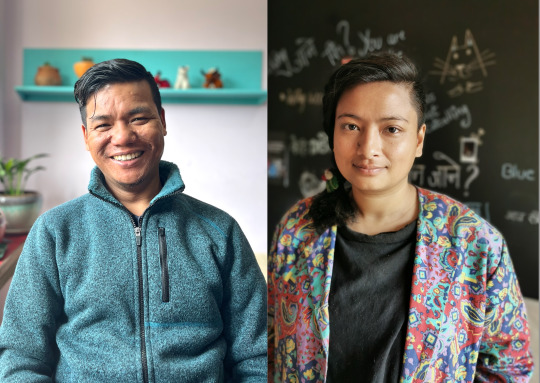
Mardi 12 décembre 2023 à 17h (heure de Paris)
Tuesday December 12th 2023, 5pm (Paris time)
Co-commissaires de la 17e Biennale Jogja 2023 et de Colomboscope 2024 / Co-curators for 17th Biennale Jogja 2023 and Colomboscope 2024
Sheelasha Rajbhandari (née en 1988) est une artiste et une curatrice opérant partir de Katmandou. Ses travaux s'appuient sur une lignée de féminités incarnées et spéculatives pour remettre en question le positionnement des femmes à travers le temps, les paysages et les cosmologies. Sa pratique incite à réfléchir au-delà de la conception néolibérale du temps, afin de décentrer les structures patriarcales qui perpétuent les cycles d'extraction industrielle et d'épuisement individuel. Pour elle, l'art consiste à créer un espace pour l'action collective. Ce questionnement alimente sa récente approche artistique et curatoriale qui recompose les notions d'indigénéité, de genre, de valeur et de productivité. Elle a été co-commissaire de la Triennale Katmandou2077, du Pavillon du Népal à la Biennale de Venise (2022), de "Garden of Ten Seasons" à Savvy Contemporary, Berlin (2022) et de "12 Baishakh", Bhaktapur (2015) aux côtés de Hit Man Gurung. Son installation textile a été exposée au Museum of Art and Design de New York (2022) et au Footscray Art Center de Melbourne (2022). Son installation dans l'exposition itinérante " A beast, a god and a line " (2018-2020) a été présentée à Para Site, Hong Kong ; TS1, Yangon ; Museum of Modern Art, Varsovie ; Kunsthall, Trondheim ; et MAIIAM Contemporary Art Museum, Chiang Mai. Elle a également été artiste en résidence au Bellas Artes Projects (2019) et au Para Site (2017). Elle a en outre exposé au Weltmuseum Wien (2019) et à la Triennale de Katmandou (2017). Dans le cadre de son collectif, elle a participé au Dhaka Art Summit (2020) et à la Biennale de Sydney (2020). Elle est également cofondatrice d'ArtTree Nepal, un collectif d'artistes, et d’un espace artistique, Kalā Kulo.
Hit Man Gurung (né en 1984) est un artiste et un curateur basé à Katmandou. Ses diverses pratiques s'intéressent au tissu des mobilités humaines, aux frictions de l'histoire et aux échecs des révolutions. Bien qu'ancrés dans l'histoire récente du Népal, ses travaux démêlent un réseau complexe de liens de parentés et d'extractions à travers les géographies qui soulignent l’exploitation inhérente au capitalisme. Ces récits tournent autour des expériences vécues par les migrant·e·s, pris·e·s entre une industrie transnationale déshumanisante fondée sur le travail, et un État-nation apathique. Il invoque en outre les méthodologies et épistémologies indigènes pour reconfigurer dans ses fondements la praxis artistique contemporaine. Il a été co-commissaire de la Triennale de Katmandou2077 (2022), du Pavillon du Népal à la Biennale de Venise (2022), de "Garden of Ten Seasons" à Savvy Contemporary, Berlin (2022) et de "12 Baishakh", Bhaktapur (2015), aux côtés de Sheelasha Rajbhandari. Il a également cofondé ArtTree Nepal, un collectif d'artistes, et l’espace artistique Kalā Kulo. Il a participé à des expositions à SAVVY Contemporary, Berlin (2020) ; Biennale de Sydney (2020) ; Artspace Sydney (2019) ; Weltmuseum Wien (2019) ; Kathmandu Triennale (2017) ; Yinchuan Biennale (2016) ; Para Site, Hong Kong (2016) ; Asia Pacific Triennial of Contemporary Art, Brisbane (2015-16) ; et Dhaka Art Summit (2014, 2016, 2018, 2020).
[EN] Sheelasha Rajbhandari (b. 1988) is an artist and curator based out of Kathmandu. Her works draw upon an embodied and speculative lineage of femininities to question the positioning of women across time, landscapes, and cosmologies. Her practice is a provocation to reflect beyond neo-liberal conception of time in order to decenter patriarchal structures that perpetuate cycles of industrial extraction and individual exhaustion. For her, art-making is about making space for collective action. This questioning feeds into her recent artistic and curatorial approach that recompose notions of Indigeneity, gender, worth, and productivity. She co-curated the Kathmandu Triennale 2077, Nepal Pavilion at Venice Biennale (2022), ‘Garden of Ten Seasons’ at Savvy Contemporary, Berlin (2022) and ’12 Baishakh,’ Bhaktapur (2015) alongside Hit Man Gurung. Her textile installation was exhibited at Museum of Art and Design; NewYork (2022), Footscray Art Center; Melbourne ( 2022). Her installation in the traveling exhibition “A beast, a god and a line” (2018-2020) was presented at Para Site, Hong Kong; TS1, Yangon; Museum of Modern Art, Warsaw; Kunsthall, Trondheim; and MAIIAM Contemporary Art Museum, Chiang Mai. She has also been an artist in residence at the Bellas Artes Projects (2019) and Para Site (2017). She has furthermore exhibited at Weltmuseum Wien (2019); and Kathmandu Triennale (2017). As a part of her collective, she has been a part of Dhaka Art Summit (2020) and Biennale of Sydney (2020). She is also the co-founder of ArtTree Nepal, an artist collective and Kalā Kulo, an arts initiative.
Hit Man Gurung (b. 1984) is an artist and curator based in Kathmandu by way of Lamjung. Gurung’s diverse practice concerns itself with the fabric of human mobilities, frictions of history, and failures of revolutions. While rooted in the recent history of Nepal, his works unravel a complex web of kinships and extraction across geographies that underscore the exploitative nature of capitalism. These narratives revolve around the lived experiences of migrants caught between a dehumanizing transnational labor-based industry and an apathetic nation-state. He furthermore invokes Indigenous methodologies and epistemologies to fundamentally reconfigure contemporary artistic praxis. Gurung is one of the curators for 17th Biennale Jogja 2023 and Colomboscope 2024. He was co-curator for the Kathmandu Triennale 2077 (2022), Nepal Pavilion at Venice Biennale (2022), ‘Garden of Ten Seasons’ at Savvy Contemporary, Berlin (2022) and ’12 Baishakh,’ Bhaktapur (2015) alongside Sheelasha Rajbhandari. He has also co-founded ArtTree Nepal, an artist collective and Kalā Kulo, an arts initiative. He has participated in exhibitions at SAVVY Contemporary, Berlin (2020); Biennale of Sydney (2020); Artspace Sydney (2019); Weltmuseum Wien (2019); Kathmandu Triennale (2017); Yinchuan Biennale (2016); Para Site, Hong Kong (2016); Asia Pacific Triennial of Contemporary Art, Brisbane (2015-16); and Dhaka Art Summit (2014, 2016, 2018, 2020)
Programmation et prochains rendez-vous sur ce site ou par abonnement à la newsletter : [email protected]
Pour regarder les séminaires antérieurs : http://www.vimeo.com/sysk/
Séminaire conçu et organisé par Patricia Falguières, Elisabeth Lebovici et Natasa Petresin-Bachelez et soutenu par la Fundación Almine y Bernard Ruiz-Picasso para el Arte
1 note
·
View note
Text
SDL: Pohewa Pāhewa: a Māori Design Kaupapa
Finding out about the curators: Desna Whaanga-Schollum, Tyrone Ohia, Graham Tipene, Johnson Witehira and Zoe Black

Desna Whaanga-Schollum
Whaanga-Schollum is the chair of the board for Artspace Aotearoa. She grew up with writer, historian, illustration and research Mere Whaanga (mother). Whaanga-Schollum collaborates with a wide group of business proffesionals, artists and academics to result an effect of change in people, practice and place. She actively participates in Māori identity design, discourse and stakeholder engagement in Aotearoa. Whaanga-Schollum is now a chair of the board for Nga Aho - a national network of Māori design professionals who come together to support each other
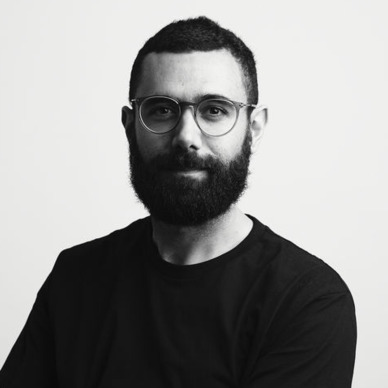
Tyrone Ohia
Ohia is the Creative Director and Founder of Extended Whānau in Tāmaki Makaurau. He graduated from UCOL in Whanganui with Computer Graphic Design. He moved to Japan for a year to experience a different culture away from NZ. He worked remotely for Alt while living in Osaka - his time in Japan helped him understand how a country's culture and its people's behavior help shape its design sensibilities.

Graham Tipine
Tipe is a tā mocko artist who has been involved in other works such as a consultant and a key artist on civic along with council-led projects through out Tāmaki Makaurau Auckland. His creativity brings Māori kaupapa into the built environment of the city - projects include Victoria Park, Auckland Library and the Tirohanga Whānui bridge in Albany.

Johnson Witehira
Witehira is a designer, artist and academic of Tamahaki. He co-founds both Indigenous Design and Innovation Aotearoa (IDIA) and Waahi Wairua. He is reconised as an expert on Māori design, his practice focuses on how customary Māori knowledge and ways of thinking can be applied in contemporary settings. Witehira has designed a typeface titled 'Māori Typeface' the idea being solely because there has not been any Māori typefaces before this, looking at textbooks or printed pages about Māori topics, it is seen that it is always set to be in helvitica, times new roman etc... he wanted to bring light into this and took matters to his own hands in designing an accessible Māori typeface.
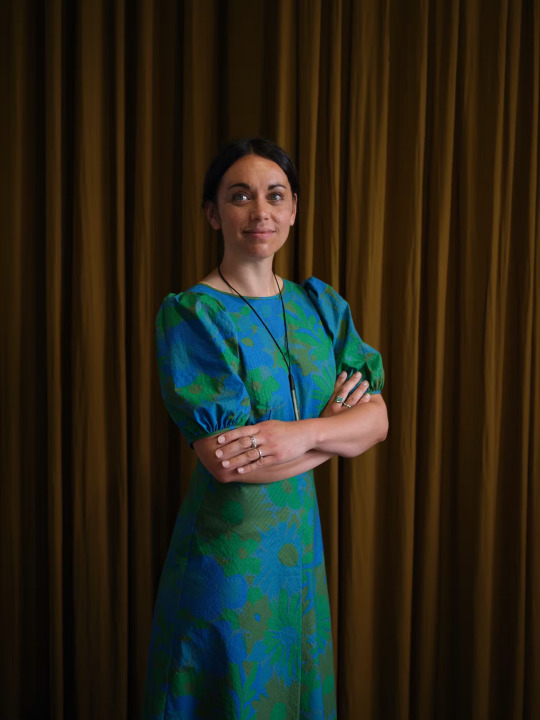
Zoe Black
Black is a deputy director in Objectspace NZ. Working in multiple galleries across NZ for the past eight years being focused on community development and advocating for critically under-represented craft and object artforms - the establishment of her position in Objectspace is an acknowledgement of Black's leadership. Black has always wanted to work with communities and artists.
0 notes
Photo

Hello from my new studio! Because recently moved in and am doing lots of things in once so still couldn’t start to making creative mess but I am so enjoying to look at it for now! I am also working on an installation project that might be a bit challenging for us. “ I am “ will be on display at the upcoming group exhibition #beautiesandbeasts at @themaingalleryau with these other excellent artist! Please come along if you like to join the celebration! Ps; Did you see my previous post about classes? Check it out, you might want to joining me to make a creative mess! . . . #themaingalleryau #ozlemyenistudio #installationart #installation #conseptart #artist #adelaide #localartist #contemporaryart (at The Main Gallery - Contemporary Artspace) https://www.instagram.com/p/Cn6F0OXpm_s/?igshid=NGJjMDIxMWI=
#beautiesandbeasts#themaingalleryau#ozlemyenistudio#installationart#installation#conseptart#artist#adelaide#localartist#contemporaryart
0 notes
Text
djcs.free [at] gmail.com
CV
b. 1994 in New Plymouth, New Zealand.
DJCS is an artist and curator from Ngāmotu. They are interested in the production of political subjectivities, dreams, and violence in postcolonial world(s), and make use of art to redistribute care, belonging and value. DJCS is the director of Enjoy Contemporary Art Space, Te Whanganui-a-Tara. Previously they were an assistant curator at Artspace Aotearoa, and were the founder of artist-run gallery Parasite, Tāmaki Makaurau. DJCS has worked in public, private and artist-run galleries since 2012, and curated independent exhibitions and events across Aotearoa.
Education:
BFA, Auckland University of Technology, Auckland, NZ
Solo & Duo Exhibitions:
2023
Backdirt (w Priscilla Rose Howe), The Physics Room, Christchurch, NZ
2022
Broken Sovereignty, Lightship, Auckland, NZ
Becoming Animals, Play_Station, Wellington, NZ
2021
Urban Nothing, RM Gallery and Project Space, Auckland, NZ
2019
Intimate Atmospheres, Artspace Aotearoa, Auckland, NZ
2018
After Jack, Window, Auckland, NZ
After Carmen, Meanwhile, Auckland, NZ
Group Exhibitions:
2022
Twisting, turning, winding, Objectspace, Auckland, NZ
Wild Once More, Te Tuhi, Auckland, NZ
2020
Social Practice, Auckland, NZ
Queer Pavilion, Auckland, NZ
2018
Under Your Skin You Look Divine, Basement Specialist Adult Store and Cruise Club, Auckland, NZ
2017
I hate you, I hate you, I hate you, because I don't hate you; I love you (curated by Misal Adnan Yildiz), Artspace Aotearoa with Michael Lett, Auckland, NZ
Curatorial:
2024
Paul Johns: Beautiful Flowers and How to Grow Them, The Dowse (via City Gallery Wellington), Wellington, NZ
Alexandra McFarlane: Extraordinary Contact, Enjoy Contemporary Art Space, Wellington, NZ
Justice for Palestine: Gaza: the Soul of Souls, Enjoy Contemporary Art Space, Wellington, NZ
Te Waka Hourua: Whītiki, Mātike, Whakatika, Enjoy Contemporary Art Space, Wellington, NZ
2022
Ciwas Tahos (Anchi Lin): mgluw tuqiy na Temahahoi/malahang cu awusa Temahahoi na tu’uy/Finding pathways to Temahahoi, Artspace Aotearoa, Auckland; The Physics Room, Christchurch, NZ
Cushla Donaldson with Quentin Lind: Neighbourhood of Truth, Artspace Aotearoa, Auckland; City Gallery Wellington, Wellington; Christchurch Art Gallery, Christchurch, NZ
Tobias Allen: The Tableau of Two Throats, S&M's Cocktail Lounge, Wellington, NZ
Prairie's Drama Club, Artspace Aotearoa, Auckland, NZ
Alexandra McFarlane: Nina’s Dance, Artspace Aotearoa, Auckland, NZ
The Killing: ILYSM, Artspace Aotearoa, Auckland, NZ
Hana Pera Aoake: te tamaiti te ao, Artspace Aotearoa, Auckland, NZ
IM/PERFECT, Artspace Aotearoa, Auckland, NZ
Nayan Patel, Parasite, Auckland, NZ
2021
Bronte Perry: Guilty Pleasures, Artspace Aotearoa, Auckland, NZ
Apexalternativeconcubine, Angel Fitzgerald, Priscilla Rose Howe, Xi Li, Ming Ranginui, Obadiah Russon & Anto Yeldezian: Cruel Optimism, Artspace Aotearoa, Auckland, NZ
Deborah Rundle: On My Volcano Grows the Grass, Parasite, Auckland, NZ
Laura Duffy: Maybe someone is starting to bloom, Parasite, Auckland, NZ
p.Walters: New World Daughter; a sterile sermon on the vile waha of a fuckin' leitī, Parasite, Auckland, NZ
Obadiah Russon: Splitting Lips, Limbs and Eyes, Parasite, Auckland, NZ
Xun Cao: Command & Conquer: The Covert Sculpture, Parasite, Auckland, NZ
Owen Connors, Nayan Patel & Aliyah Winter: Salon De La Mort, Auckland Art Fair, Auckland, NZ
2020
Owen Connors: For Future Breeders, Parasite, Auckland, NZ
Nayan Patel: Still Life, Parasite, Auckland, NZ
Samuel Te Kani: Daddy, Parasite, Auckland, NZ
Aliyah Winter: Hypno.Matrix, Parasite, Auckland, NZ
Ali Senescall: As Above So Below, Parasite, Auckland, NZ
Ali Senescall, Tash Keddy & Samuel Te Kani: On Rat Bones, May Fair Art Fair, Auckland, NZ
Tash Keddy: Grind House, Parasite, Auckland, NZ
2018
val smith, Jordana Bragg, Tash Keddy, Lila Bullen-Smith, Owen Connors, Aliyah Winter, Abbey Gamit, Richard Orjis, Juliet Carpenter with George Banach-Salas, Ary Jansen, Samuel Te Kani, Jessica Morgan, Alice Senescall, Jaimee Stockman-Young, Magdalena Hoult, Natasha Matila-Smith, Hera Wing, DJCS: Under Your Skin You Look Divine, Basement Specialist Adult Store and Cruise Club, Auckland, NZ
2017
Abby Gamit, Allyson Hambert, Tommo Jiang, Samuel Te Kani, Bronte Perry, Pati Solomona Tyrell, Jaimee Stockman Young: The Windows Are Alive, Auckland Pride Festival, Auckland, NZ
2016
Penny Goring, Aurelia Guo, Orion Facey, Zarah Butcher-McGunnigle, George Watson, Jack Hadley, Cristine Brache, Clara Chon, Katherine Botton, Hana Pera Aoake, Owen Connors: NSFW, New Zealand Fashion Week, Auckland, NZ
Lila Bullen-Smith, Ashleigh Fanauga Tofa, Hipera Kelly, Jessica Robins, Nadine Paredes, Tommo Jiang, Quishile Charan, Talei Yates, Uma Tuffnell: dorf, White Night, Auckland Central Library, Auckland, NZ
Ashley Fanuga Tofa, Bridget Rigger, Brittany French, Cameron Ah Loo-Matamua, Dan Nash, Emilie Rākete, Faith Wilson, Hana Pera Aoake, Haley Jean, Jennifer Katherine Shields, Hera Wing, Jess Francis, Lana Lopesi, Lila Bullen-Smith, Mya Middleton, Piu Piu Maya Turei, Quishile Charan, Robin Murphy, Ruby Papāli’i-Curtin, Sacha Donnell, Samuel Te Kani, Theo Macdonald, Tash Keddy, Dreary Modern Life, Hapori, Hashtag500words, Parahistory, Yoursdankley: Bus of Tales, White Night, Auckland Central Library, Auckland, NZ
2015
Mobile Library, White Night, Auckland Central Library, Auckland, NZ
Residencies & Grants:
2021
Creative New Zealand Arts Grant
2020
Creative New Zealand Arts Continuity Grant
2019
Artist-in-residence, RM Gallery, Auckland, NZ
0 notes
Photo

Natura Viva is a video, sound and drawings installation I co-created with artists Jeppe Worning and Noelia Mora Solvez. It first exhibited at KH7artspace in Aarhus in february of 2020, and later the same year at Skanderborg Museum.
---
‘The human body is not just one thing, but our indispensable starting point for understanding and experiencing the world at all.
It is the contemporary experience of the outside and the inside. The place from which we must experience our lives, ourselves and our surroundings, and the place from which we can ask the world questions and wonder about it. Does this mean that another body would give a different understanding of the world? Would it open to another world at all?
These are some of the issues that Natura Viva explores with its playful and engaging aesthetics of shared, divided and re-composed bodies. The work is full of bodies, but new bodies, bodies we do not know, body parts without body and bodies with too much body. In the midst of all these new body synths, it also turns out that another look at the world has opened up.
The work asks about the relationship between the body and the landscape. The relationship between the gaze and the thing, the organic and the inorganic, and not least the relationship between the subject and the object. At all of these impossible thresholds, a simple yet poetic installation balances the audience through a corridor of two enormous drawings and video projections. Together, it constitutes a work that is at once distant and sensual, intimate and alien, abhorrent and attractive.
Christoffer Brekne, Jeppe Worning and Noelia Mora Solvez have created a multifaceted installation of ink on paper combined with video projection and sound installation, drawing on their diverse backgrounds in film, visual arts and performance. Brekne works visually with performing arts, films and multimedia installations. Worning works with hand-drawn works on paper, and Solvez is a video and performance artist. It is with these diverse approaches and crafts that the artists have created an installation that can be experienced on different levels and in many layers.’
Text by Anders Ruby.
Support: KH7 artspace and the City of Aarhus.
0 notes
Text
WEEK 3 - Sept. 20
Scholarly Research...

Billard, Jillian. “Body Politic: 10 Radical Artists Who Use Dance as a Medium.” Artspace, October 31, 2017. https://www.artspace.com/magazine/art_101/in_focus/the-body-as-art-contemporary-dance-enters-the-museum-55082.
When dance entered the realm of visual art in the 50's and 60's artists embraced the body—the meeting point between the public and the personal—specifically in the form of choreographed and improvised movement.

Heyward, Anna. “How to Write a Dance.” The Paris Review, March 1, 2016. https://www.theparisreview.org/blog/2015/02/04/how-to-write-a-dance/.
Dance Notation was a way to preserve dance before image-capturing technology, it was basically like storyboarding a performance. The images of dance notation are really captivating to me.



“Guadalupe Maravilla Is Healing Generational Trauma through Art and Sound.” Whitewall. Accessed October 1, 2022. https://whitewall.art/art/guadalupe-maravilla-is-healing-generational-trauma-through-art-and-sound.

Scholarly Reflection
Thinking more about movement in my project through stop motion, dance, and performance led me to finding scores of dances. This is a beautiful way to visualize and document movement and the order of movements that might be intentional in telling a specific story. Looking at other artists work on generational trauma is interesting, I think it is helpful for me to see other ways people are trying to visually and physically work through their own experiences.
0 notes
Photo

Most uncommon and rare to find this collodion silver print (celloidin, aristotype) of a Japanese Geisha 芸者 in her underwear (1895) for a collections-based project I’m working on © photo Tanya Rusnak
Of course, the archive is hardly a new theme in contemporary art. The art historian Hal Foster's 2004 essay "The Archival Impulse" defined archival art as a genre that “make[s] historical information, often lost or displaced, physically present. To this end [archival artists] elaborate on the found image, object, and favor the installation format.” Whether this happens in the form of projects dealing with real archival material or artworks in which artists use the archive as a theme (sometimes even inventing material), the idea of the archive continues to be an undeniable force and organizing structure in exhibitions today.
Excerpt, How the Art World Caught Archive Fever, Artspace Editors, Jan 2014
35 notes
·
View notes
Text
Whatever You Want To Learn About Art Fairs
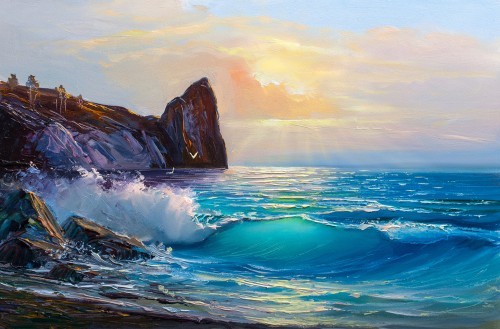
Is it true that the thought of needing to browse your way all by your lonesome sound? Are you currently completely at a loss regarding where you can go, the way to purchase tickets, or, most importantly, what to utilize? If you watched a job you liked, do you realize --or even if --to get it? Never heard about a artwork fair previously? Well, worry not: we at Artspace have created a handy guide that may remedy all of your pertinent questions which means you are going to know if to proceed, things to watch, and the way exactly to make the most of these decadent souks. Art-fairs stay the primary financial model for the artwork market. You must see https://www.nytimes.com/2016/10/21/arts/design/9-rarities-appearing-at-a-new-york-art-fairs-debut.html and also you may learn wonderful aspects of art fairs.
What is the art fair?
Superior problem! On the simplest stage, an art fair can be a commerce show--i.e. a location for men and women inside the art business, from dealers and art advisors to curators, to kibbutz and create deals. But fairs are additionally and exhibitors have a tendency to pepper those events together with spectacular pieces catch the creativity of photographers and to delight crowds.
Art fairs are crowded and spacious and also confusing. Can I will need to really go?
Effectively, that is different. If you wish to stay abreast of the hottest job being make by probably the most obvious artists of this day, and also the many cutting-edge art trends from round the world, then your reply is indeed --there's simply no substitute for wading throughout the miles of aisles in these things and taking all of the artwork. If you are more enthusiastic about engaging with the highest-quality art that is contemporary, then the reply is no. However in this circumstance you ought to await the artwork to go. By which time, in the event you required to purchase something, you would probably be out of luck.
If you have limited time, then just how do you choose which fair to go to?
If time isn't on your side--and let's be honest, just art pros may afford to devote days on end to fairs--your very best option may be to stay glued to the greatest functions, and you will understand these really are because the record of birthdays that are fair is usually known as their"week" (à manhattan project Armory Week, Frieze Week, or even Art Basel Miami Beach Week). Perhaps not just do these fairs attract traders and the most galleries demonstrating works you are going to know, but the larger fairs will also possess more stalls interval. In the event that you'd rather find less expensive job by offbeat or famous artists, then you may possibly want the joys of browsing the satellite fairs.
Can you ought to buy your ticket?
When they available to the people, you must not worry about being forced to buy a ticket if you're planning on going to the fairs. But the only way for you is to purchase your tickets in advance, if you'd like to walkthrough a fair throughout special preview hrs or visit a distinctive VIP occasion.
What exactly does a VIP ticket catch you?
Entry. Doled out by fairs within an increasingly exclusive basis for a small pool of collectors and artwork insiders, these Willy Wonka-esque moves gain you entree to your number of the sort of fancy amenities that make lots of everyday individuals see the Artworld as anything akin to this court of Louis IV. If you're in the maximal echelon of the art elite you'll be able to find yourself a private car in your beck and call, extremely ancient entrance into this fair, along with also an open door to various extra-special activities across the metropolis, from posh events into tours of collectors' domiciles and artists' studios.
Is there a ideal evening to stay fair?
If you you wish your nose pressed against the fair's doors ahead of the VIP opening in the minutes. Enterprising collectors much beforehand, however what you do often purchases Will work at fairs, what you notice isn't necessarily what it's possible to find. Even however it should go without mentioning that weekend afternoons may well be a small crowded if you are just looking to browse, remain in anytime.
Unlike a few podunk county fairs at which it's likely you need to be concerned about falling less than just about public restroom options, the artwork fairs grounds are large and by held in established institutional structures with bathroom alternatives that are nice. The lines, on the other hand, can be far from acceptable.
2 notes
·
View notes
Photo

Clouds ☁️ the contrast of man made & nature 🥰 it is the things we notice that makes us sing 🎶 (at Project Contemporary Artspace) https://www.instagram.com/p/CFK8LNqjXEd/?igshid=8ldlh5wukvmw
1 note
·
View note
Text
10 Unmissable Art Exhibitions Of 2020
10 Unmissable Art Exhibitions Of 2020
Art
by Sally Tabart
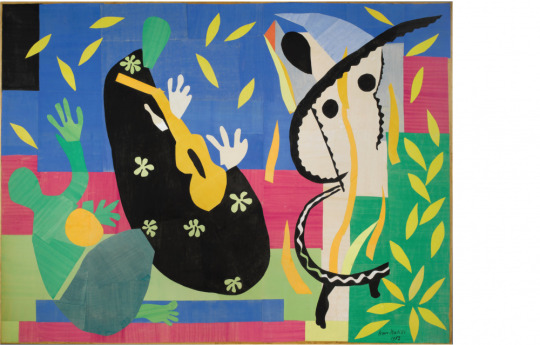
Henri Matisse – ‘The sorrow of the king (La tristesse du roi)’ , 1952. gouache on paper, cut and pasted, mounted on canvas. Courtesy of AGNSW.
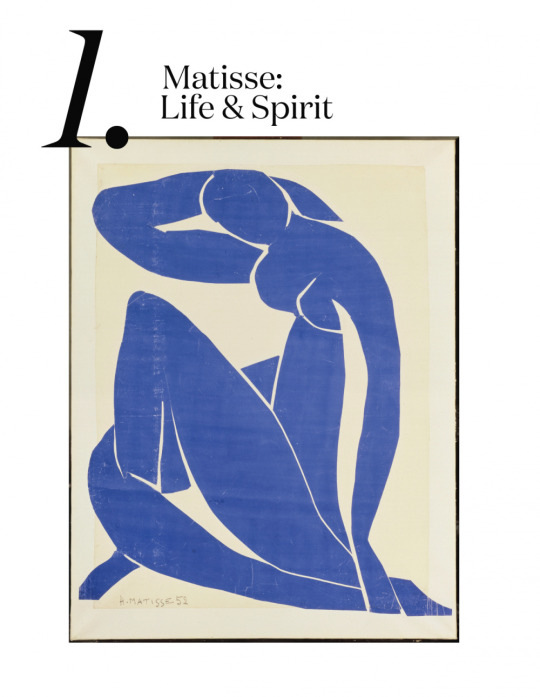
Henri Matisse – ‘Blue nude II (Nu bleu II)’ 1952. Courtesy of AGNSW.
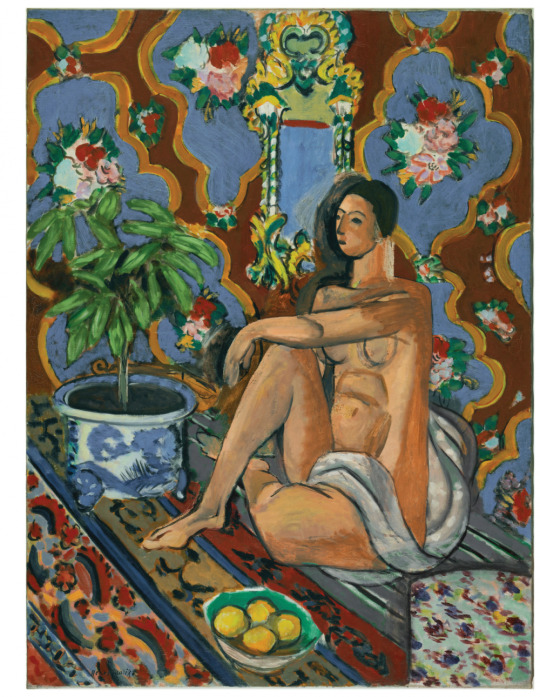
Henri Matisse – ‘Decorative figure on an ornamental ground (Figure décorative sur fond ornemental)’, 1925. Courtesy of AGNSW.
Matisse: Life & Spirit
November 2020 – March 2021
Art Gallery of New South Wales, NSW
It’s no surprise that one of the most prestigious galleries in the country, Art Gallery of New South Wales (AGNSW) will show a dynamic exhibition from one of the most famous and influential artists of all time, Henri Matisse.
Exclusive to AGNSW, Matisse: life & spirit, masterpieces from the Centre Pompidou will show over 100 works spanning six decades from the French master.
Developed alongside the Centre Pompidou in Paris, known for its unmatched collection of Matisse works, Matisse: life & spirit will be the greatest single exhibition of Matisse masterworks ever to be seen in Sydney. Yep – you’ll be able to see his famed cut-outs, but also his adventures in paintings, sculptures, and drawings, tracking the vast and varied exploration of his artistic career. This is TRULY unmissable!

Left to right: Dhuwarrwarr Marika Makassan, swords and long knives, Carlene Thompson, Kipara and Kalaya. Photo – courtesy of MAGNT.
Telstra National Aboriginal and Torres Strait Islander Art Awards (NATSIAA)
August 8th 2020 – January 31st 2021
Museum and Art Gallery Northern Territory, NT
Now in its 36th year, the Telstra National Aboriginal and Torres Strait Islander Art Awards (NATSIAA) is a major highlight for the Museum and Art Gallery of Northern Territory (MAGNT) in Darwin. This fantastic exhibition spotlights emerging and established Aboriginal and Torres Strait Islander artists across a varying range of mediums, and attracts more than 85,000 visitors.
This exhibition is so important for visitors to gain an insight into First Nations People’s perspective in both contemporary interpretations, as well as those steeped in generations of tradition. It also offers some prize money of up to $50,000 for winning artists, courtesy of longtime sponsor Telstra. All finalists’ work will be displayed in the world-class exhibition, opening in August.
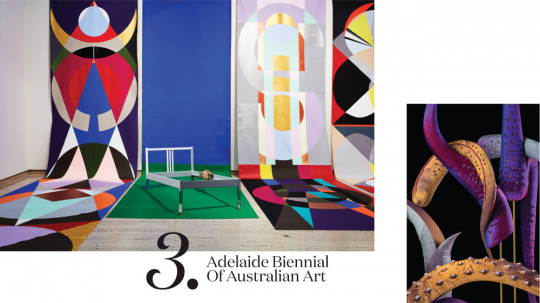
Left: Mikala Dwyer: a shape of thought featuring The Angel; Possession; Sigil for Heaven and Earth by Mikala Dwyer, Art Gallery of New South Wales, Sydney, 2017. Photo – Mim Stirling. Right: Julia Robinson, Australia, 1981, Beatrice, 2019–20.
Adelaide Biennial of Australian Art
February 29th – June 8th 2020
Art Gallery South Australia, SA
This year the Art Gallery of South Australia welcomes the hugely popular Adelaide Biennial of Australian Art back for its 30th year. Known for its risk-taking and expansive vision, the Biennial welcomes the wild, wacky, weird and wonderful.
The theme of the 2020 iteration is Monster Theatres, inviting artists to bring to life the ‘monsters’ of today. As described by curator Leigh Robb, ‘Monsters ask us to interrogate our relationships with each other, the environment and technology. They force us to question our empathy towards differences across race, gender, sexuality and spirituality.’
Artists involved in the Biennial include Abdul Abdullah, Polly Borland, Yhonnie Scarce + many more!
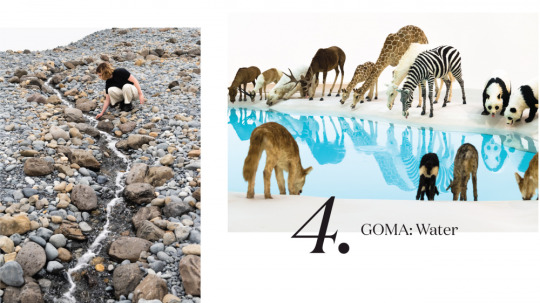
Olafur Eliasson, Riverbed 2014. Photo – Natasha Harth, QAGOMA.
Water
December 7th 2019 – April 26th 2020
Gallery of Modern Art, QLD
Brisbane’s Gallery of Modern Art never fails to disappoint with its innovative, world-class programming – and Water is no exception! Exploring the theme of, you guessed it, Water, this exhibition explores this vital element from the perspective of artists around the world.
Here is some of what you can expect, according to GOMA:
‘Walk across a vast, rocky riverbed created by Olafur Eliasson. See animals from around the world gather together to drink from Cai Guo-Qiang’s brilliant blue waterhole. Gaze at Peter Fischli and David Weiss’s snowman frozen in Brisbane’s summer heat. Traverse a cloud of suspended gymnastic rings in a participatory artwork by William Forsythe. View the tidal currents rise and fall around Angela Tiatia. Reflect on the cultural traditions of bodies of water with Judy Watson, and on the long history of our reliance on water through Megan Cope’s re-created midden.’

Left to Right: Photo by Beth Wilkinson for Lindsay. Stanislava Pinchuk, ‘Topography : Topsoil Storage II, Fukushima Nuclear Exclusion Zone.’ Pin-holes on paper, 2017. Image courtesy of the artist. Photo – Matthew R. Stanton. Stanislava Pinchuk, ‘Topography : The Road to the Fukushima Daiichi Nuclear Plant’. Pin-holes on paper, 2017. Photo – Matthew R. Stanton.
Stanislava Pinchuk
June 27th – October 4th 2020
Heide Museum of Modern Art, VIC
Stanislava Pinchuk (also known by her pseudonym, Miso) has emerged as one of Australia’s intriguing contemporary artists in the last decade. The Ukranian-born, Melbourne-based artist captures the changing topographies of war and conflict zones through data mapping, making tiny, individual pin pricks to realise these patterns – an incredibly labour-intensive and mentally and physically draining process that appears effortless, and beautiful.
This major exhibition at Heide Museum of Modern Art in Melbourne will feature a survey of Stanislava’s most powerful pinprick projects from the past five years, accompanied by terrazzo-like sculptures comprised of pieces of debris left behind in conflict zones.
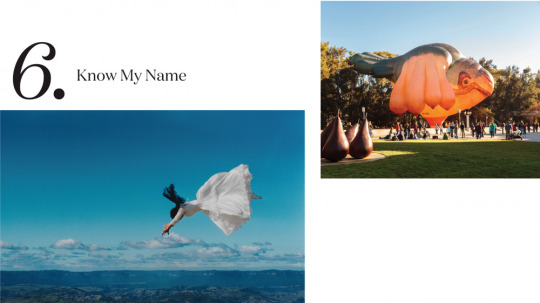
Know My Name: Australian Women Artists 1900 to Now
May 30th – September 13th 2020
National Gallery of Australia, ACT
The National Gallery of Australia (NGA) celebrates its ongoing initiative to increase representation of artists who identify as women with Know My Name: Australian Women Artists 1900 to Now.
Drawing on works from the National Gallery’s own collection, as well as others from across Australia, Know My Name showcases the work of lesser-known artists alongside Australian greats from different times, places and cultures.
As part of the broader Know My Name initiative, a new commission by the Tjanpi Desert Weavers will be on display at the National Gallery. Patricia Piccinini’s iconic Skywhale (2013) will also see its new counterpart, Skywhalepapa (2020) ascend over Canberra on its maiden voyage, travelling alongside Skywhale eight times during the exhibition period.
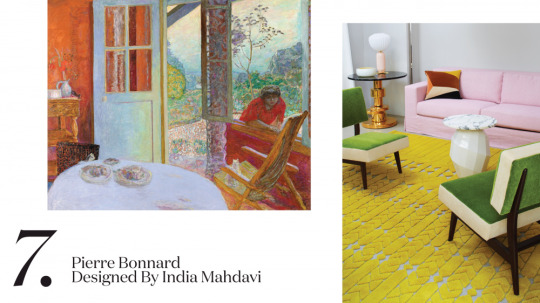
Left: Pierre Bonnard – French 1867–1947 The dining room in the country, 1913. Right: India Mahdavi (designer). Jardin d’intérieur – collection for La Manufacture de Cogolin. Images courtesy of the NGV.
Pierre Bonnard designed by India Mahdavi
June 5th – October 4th 2020
National Gallery of Victoria
While Sydney-siders enjoy the masterful works of Henri Matisse, Melbournites won’t miss out on the opportunity to experience an incredible exhibition of another beloved French painter! The exquisite works of Pierre Bonnard will be on show at the National Gallery of Victoria (NGV) for their major winter showcase, a kaleidoscopic exhibition of 150 works from the painter with a fondness for domestic scenes and rural life. Pierre Bonnard has been developed in partnership with Musee d’Orsay in Paris.
Described by Matisse, a close friend of Bonnard’s, as ‘a great painter, for today and definitely also for the future’, this groundbreaking exhibition spans paintings, drawings, photographs, folding screens and early cinema, depicting scenes of modern 20th century France in bright, vivid colours.
Aside from the opportunity to see one of the works of this beloved painter, what makes this exhibition absolutely unmissable is the design of the show itself. Iranian Paris-based designer India Mahdavi (the interiors genius behind the iconic pink Gallery at Sketch restaurant in London) has been commissioned by the NGV to bring Bonnard’s extraordinary works to life, elegantly balancing historical references with contemporary culture in an immersive experience.

22nd Biennale of Sydney, NIRIN
November 8th 2020 – 16th February 2021
Various locations, NSW
First held in 1973 as part of the opening celebrations of the Sydney Opera House, the Biennale of Sydney is now in its 22nd year and is one of Australia’s blockbuster contemporary art events.
Taking place across six major sites – Art Gallery of New South Wales, Artspace, Campbelltown Arts Centre, Cockatoo Island, Museum of Contemporary Art Australia and the National Art School – the Biennale of Sydney will see 94 artists from 47 countries
Under the guidance of multidisciplinary artist and this year’s Biennale Artistic Director Brook Andrew, the 12-week exhibition is titled NIRIN, meaning ‘edge’ in Brook’s mother’s Nation – the Wiradjuri people of western New South Wales. He says, ‘Optimism from chaos drives artists in NIRIN to resolve the often hidden or ignored urgency surrounding contemporary life.’

Carriageworks Commissions
Rebecca Baumann: Radiant Flux, January 8th – June 14th
Reko Rennie: REMEMBER ME, January 2020 – January 2021
Kate Mitchell: All Auras Touch, January 8th – March 1st
Daniel Boyd: Video Works, January 8th – March 1st
Australia’s largest multi-arts centre, Carriageworks, has been home to some pretty major large-scale installation commissions in its time (who could forget German artist Katherina Grosse’s otherworldly technicoloured universe in 2018?). This summer, four new site-specific commissions from leading Australian artists Rebecca Baumann, Daniel Boyd, Kate Mitchell and Reko Rennie have taken residence in the epic historical space.
Spanning over 100-metres, Rebecca Baumann’s Radiant Flux sees every glass surface of the building’s exterior covered in a film that changes colour at every angle, flooding the space with kaleidoscopic light that will never be the same twice.
A study in human energy, All Aurus Touch by Kate Mitchell captures an aura portrait for each of the 1,023 census-recognised occupations.
Video Works by Kudjala/Gangalu artist Daniel Boyd features three major video installations, where gallery walls will be mapped with the artist’s otherworldly, infinite cosmos.
Interdisciplinary Kamilaroi artist Reko Rennie references the massacre of First Nations people in Remember Me, a massive illuminated sign that will remain on display for the whole of 2020, the year marking the 250th anniversary of Captain Cook’s first landfall.

Installation view of the Archibald, Wynne and Sulman Prizes 2019 exhibition at the Art Gallery of New South Wales, Sydney. Photo: AGNSW.
Archibald, Wynne & Sulman Prizes
May 9th – September 6th 2020
Art Gallery of New South Wales, NSW
The Archibald, Wynne & Sulman Prizes are some of the most prestigious and highly anticipated art events in the country. Since its inception in 1921, The Archibald Prize the most well-known of the three awards celebrates paintings of notable figures that reflect Australian culture across areas including art, media, entertainment, politics, sports and more. The works are always a great capsule to represent Australian culture of the moment.
Finalists for the Archibald (portrait), Wynne (landscape/scenery) and Sulman (genre/subject) are shown in an exhibition that starts at the Art Gallery of New South Wales, and tours at select galleries around Australia for the remainder of the year.
1 note
·
View note
Video
vimeo
Coinciding with their 10th birthday on November 14, 2019, Nottingham Contemporary have released an enhanced virtual reality experience developed by V21 Artspace of their exhibition, Still I Rise: Feminisms, Gender, Resistance, Act 1 (2018–19). Still I Rise explores the history of resistance and alternative forms of living from the perspective of gender. With over 100 exhibits by some 50 practitioners, Still I Rise looks at resistance globally, from intimate acts to large-scale uprisings, from the late 19th century to the present and beyond. Grounded in intersectional queer and feminist thinking, the project discards linear models of progress in order to connect a multiplicity of voices across space and time. Composed of several iterations, Act 2 was at De La Warr Pavilion, Bexhill-on-Sea (2019), and Act 3 is presented at Arnolfini, Bristol, until December 15, 2019. Nottingham Contemporary’s fully 3D-rendered, interactive interpretation of Still I Rise extends the exhibition’s aim to broaden discussions around gender and resistance, and to represent international perspectives. It is free to download across Oculus Go and HTC Vive, and can also be viewed via web browsers, with versions for mobile devices due in December 2019. The fully-immersive VR experience centres on the gallery “A Spell: Feminism Beyond Humanism,” which concerns rituals, subject-making and reinvention as strategies of resistance. It includes fully interactive artworks, including new commissions by Ad Minoliti, Osias Yanov and Jesse Jones, as well as works by Tai Shani, Bruno Pelassy and Jeneen Frei Njootli The experience includes a video archive of the Public Programme events that took place during the exhibition at Nottingham Contemporary. This includes a three-day gathering titled “Who Must Be Free Themselves Must Strike the Blow”, which presented multiple voices questioning the production of feminist discourse, resistance strategies, gender abolition and more. This VR release coincides with the tenth anniversary of Nottingham Contemporary. Since opening, more than two million people have visited more than 60 exhibitions of international contemporary art, as well as 1,000 free-to-attend events, talks and educational programmes. Nottingham Contemporary was shortlisted for Art Fund Museum of the Year 2019. The VR experience was developed by V21 Artspace as part of a research and development programme supported by The Space, an agency that supports the UK arts and cultural sector to make great art and reach new audiences using digital media, content and platforms. Still I Rise is a collaboration between Nottingham Contemporary and the De La Warr Pavilion in Bexhill-on-Sea. It has been curated by Irene Aristizábal (Formerly Head of Exhibitions at Nottingham Contemporary, now Head of Curatorial & Public Practice at BALTIC), Rosie Cooper (De La Warr Pavilion) and Cédric Fauq (Nottingham Contemporary) with the support of Phoebe Cripps, Emma Gamble, Effy Harle, DaeNyce’ Rabain, Abi Spinks and Ben Urban. Exhibiting artists and collectives include: Amina Ahmed, Barby Asante, Alice Constance Austin, Xenobia Bailey, Glenn Belverio (Glennda Orgasm), Pauline Boudry/Renate Lorenz, Carolina Caycedo, Judy Chicago, Phyllis Christopher, Jackie Collins and Pat Garrett, Blondell Cummings, Feminist Land Art Retreat, Guo Fengyi, Jeneen Frei Njootli, Chiara Fumai, Eduardo Gil, Anna Halprin, Margaret Harrison, Jesse Jones, Hayv Kahraman, Corita Kent, Donna Kukama, Suzanne Lacy and Leslie Labowitz Starus, Ellen Lesperance, Zoe Leonard, Mary Lowndes, Alex Martinis Roe, Ana Mendieta, Louise Michel, Ad Minoliti, Senga Nengudi, Ni Una Menos, Okwui Okpokwasili, 0rphan Drift, Bruno Pelassy, Faith Ringgold, Lala Rukh, Zorka Ságlová, Victoria Santa Cruz, See Red Women's Workshop, Tai Shani, Pamela Singh, Terence Smith (Joan Jett Blakk), Linda Stupart, Ramaya Tegegne, Jala Wahid, Faith Wilding, Osías Yanov. Exhibition Circle: Belmacz, Catherine Petitgas, Young Collectors Collective, Camel Assembly.
1 note
·
View note
Text
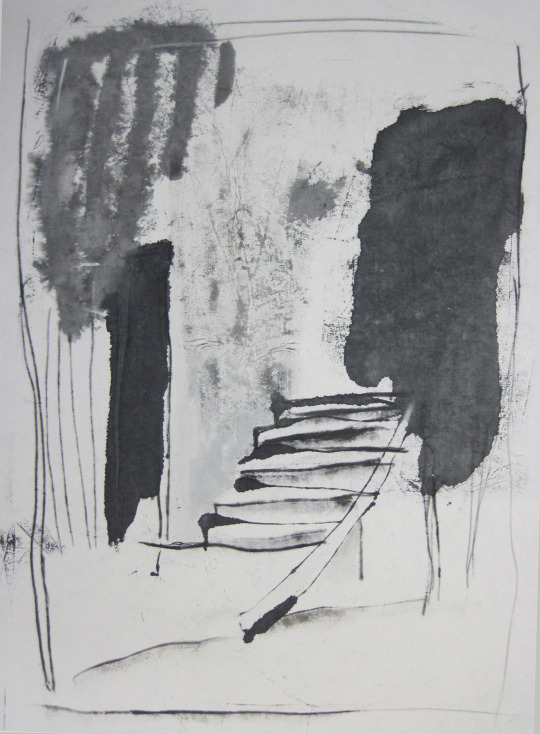
10AAA, SpaceBA | Curated by Song Yovi: From Here to Eternity No.5 Turku
B-galleria 20.11-01.12.2019
The opening reception on tuesday 19.11. klo 18-20. Welcome!
Täältä ikuisuuteen
From Here to Eternity No.5.Turku-The research of temporality and eternity of contemporary art>
Venue: B-galleria, Turku
Date: 20/11/2019-1/12/2019 | Opening reception: 19/11/2019
Artist: Gemini Kim, WURI, Hanae Utamura, Josef Bares, Kim Sanghyun, Kim Sea Joong, Lee Dahyeun, Eunuk Lee, Im Do One, Won Jongim, JY Rue, Shin Kiwoun, Ha Seok Jun
Organised by B-galleria, 10AAA, SpaceBA | Curated by Song Yovi
B-galleria is pleased to announce international group show titled, From Here to Eternity No.5 Turku, co-organised by 10AAA and SpaceBA(curator, Song Yovi) and 13 international artists. Exhibition at B-galleria on November consists of artists who subject the objects that are easy to fade away. Artists have reformed and even recreated their previous works and, through that process, they also have expressed the efforts to find a way to preserve them with manual for the artworks. The dilemma in artwork, temporality, mortality, and eternity, is to be reperceived through artists’ "Art Resurrection".
This project presented at the Seoul Gallery Factory in 2014 through the works of artists, who take easy-to-disappear objects as works of art. It was started as the main theme to explore. The project also considers the "mobility" of works that are not only one time but are reproduced sequentially in another area or another space. For the artists, we requested a device and manual in consideration of 'movement' and 'preservation'. In 2015, we carried out a research on 'variable' installation where the works are composed in a more expanded space in Gallery Purple in Namyangju. In 2017, the project presented the artworks at the oMo artspace in Berlin as the exhibition for international exchange.
The exhibition itself defies “Temporality”. It wouldn’t be one-time event nor same contents in different places rather continuous to live as “Absence of Artists” and “In Another Space”. The living of the exhibition would be the experiment and the journey to find the answer if a work of art could be expressed properly in the absence of the creator.
More information:_10AAA(Director_Song Yovi) is a project-based group which consists of art enthusiasts. Our aim is to share innovative ideas and to organize and present a series of artistic events in collaboration with creative people so that we could provide a bridge. www.facebook.com/10aaa | www.10aaa.co.uk | @10aaa_uk_korea
SpaceBA is LCC/non-profit-organisation located in Sewoon SangGa in Seoul. We started from an artist’s life and studios problem and they are running several international exchange project.This space has managed by artists, law consultant, space designer and curator, www.spaceba.org | @sewoon_spaceba
1 note
·
View note
Text
Curating on the web: a provisional typology
When trying to say something substantial about either ‘the internet’ or ‘the arts’, I think of an ouroboros: the symbol of a snake eating its own tail to denote a self-reflexive entity in a state of constant flux. Both the internet and the arts aren’t easily captured by definitions and - as they both develop with the speed of annoying Youtube commercials - their relationship is constantly redefined through a myriad of unexpected and often subversive combinations. This makes writing about curating on the web, a fully self-imposed pain in the butt and most likely perishable act. This being said, I have made a first attempt in writing a provisional typology that maps out influential theories and perspectives on using the internet as platform for exhibiting art. Today, I see many ways in which online curatorial practices take form, but in order to understand some of the parameters at play, it is vital to sweep over the relationship between the arts and the internet from the beginning.
Curating art after new media: three defining developments
The birth of the internet was quickly followed by the birth of Internet Art, and - after some of the initial buzz of networked technologies had cooled down - became soon a popular vessel for institutional and social critique. Performing through a then-alternative space than the traditional art-circuit, these Net Art-projects often worked around institutional critique and gender, but also questioned distinctions of taste and hierarchy. Net Art here, is often interpreted as an expression and continuation of movements such as Dada, Fluxus and telematic art (Ippolito, 2002); their networked, interactive and collaborative nature are seen as vital characteristics of their existence. Early Net Art was often more about process than about outcome (Greene, 2002; Graham, 2010), which did not make it easy to categorize and exhibit them through traditional museological approaches. Internet in these cases was both used as medium and ‘exhibition’-platform, celebrated by its decentralized, networked and collaborative character. (Nowadays, some might argue it also coincided with a slightly naive look at the internet being a virtual space of unprecedented freedom, liberated from bias and capitalistic motives.)
Of course, the networked possibilities of the web did not only have consequences for art objects itself, but also to their regulation and facilitation. From the 1990s onwards, internet and digital technologies influenced a new approach towards curatorial practice. I will outline three important ways in which art travels across the internet, and the internet is used as platform to display art.
First, one can think of the giant splurge of art that became available through - relatively - decentralized online practices. With improved bandwidth infiltrating our schools, homes and libraries, artists did not necessarily needed to be represented by a gallery to reach an audience, but could display their art online. Through purposefully designed art-platforms such as Ello or Behance, to more general (social) media platforms as Facebook, Vimeo or Instagram, art has nowadays nestled in the nooks and crannies of the internet, or unexpectedly pops up in our feeds. In some of these cases, art is created solely through digital software, making the internet the first - or even the most natural - place to use as platform for display. Other times, art is created physically, and the internet is used as vehicle to bring a visual counterpart of the piece to an audience. In these examples, the online presentation of arts does not share the ‘typical’ characteristics of Net Art, but the internet forms a vital - or even most important - platform for their display.
A second way to look at curating on the web are through academic texts on the consequences of the internet for curating arts - written by various key figures from the new media arts scene. Influential authors are Dietz, Krysa, Paul, and ONeill, and although their vision towards the early-day promises of internet and web art differs, they all have profound experience in curating new media art and a vast understanding of the internet and its constituting elements. What most of these approaches have in common are the following characteristics as defined by Christiane Paul (Adjunct Curator of New Media Arts at the Whitney Museum). She writes online curatorial practices differ in the way art-objects are selected, presented, ’filtered’ and being ‘gate-kept’. “With its inherent flexibility and possibilities for customization and indexing, the digital medium potentially allows for an increased public involvement in the curatorial process, a ‘public curating’ that promises to construct more ‘democratic’ and participatory forms of filtering (2006)”. Whereas some of these scholars view the web as a virtual ‘immaterial’ place, and mostly focus on curating new media art through alternative forms of organization, others embrace more traditional institutionalized bodies and describe how museums very early on tried to embrace and experiment with new forms of curating new media art (such as Walker Art Center’s Gallery 9, MOMA’s e-space and Whitney Museum’s artport). An important distinction from the third point outlined below is that the majority of these scholars focus on New Media Art, and thus, consider art practices and projects that consider the internet or a new media environment as their natural habitat.
Third, there has been a large impetus from museums to render visible their collections outside of the confines of the museum walls. In these instances, it concerns traditionally organized, hierarchical institutions or organizations that are finding ways in which the internet can be used as tool for displaying objects that were not developed to be exhibited in an online environment. Scholars who have written about these approaches are Foo (2008) and Koon (2014) and consider online exhibitions fore mostly as online display of archival and library content. These exhibitions are sometimes considered as an online counterpart, or extension of a physical exhibition organized at an actual venue. One could think of the feminist exhibition that produced a specially named website called WACK! Art and the Feminist Revolution, curated by Connie Butler for the Los Angeles Museum of Contemporary Art (MOCA) in 2007. As Art Historian Greenberg (2018) - who analyzes the roles of history and memory in recent exhibition practices - writes, “the stated purpose of the WACKsite was to “enrich viewer understanding” of the exhibition and its many components. The exhibition itself was the first comprehensive historical examination of the international foundations and legacy of feminist art. It combined the display of 120 artists with extensive programming. The website was conceived as an integral component of the exhibition and was designed to incorporate multimedia and interactivity.” In these cases the internet is often used as web-based multimedia information system and intended to offer the user respectively more depth and interaction in addition to their physical counterpart. When these initiatives sprout from institutionalized arts environments there is usually an educational incentive present as well.
Provisional Typology
Today, the internet has permeated into every aspect of our lives, which has led some art-scholars to dub the current (digital) climate as the postinternet era. ‘Postinternet’ does not suggest that the Net and all its technological developments are behind us and finished, but entails a movement past the internet as novelty (as was usually the case with early Net Art), and using the internet and digital strategies for a more broader range of artistic practices and objectives (Artspace, 2014). As cultural critic and curator Micheal Connor quotes artist Mark Tribe in his influential article on postinternet art on Rhizome:
“postinternet artists stand on the shoulders of Net art giants like Olia Lialina, Vuk Cosic, and JODI, not in order to lift themselves higher into the thin atmosphere of pure online presence but rather to crush the past and reassemble the fragments in strange on/offline hybrid forms.” (Connor, 2013)
Whereas early literature on curating often presumes a false binary between the online and offline sphere, today’s environment acknowledges that practically everything is touched by digital influences. In a Western context, Internet is seen as integrated part of everyone’s lives, and postinternet art often incorporates to a higher degree the physical world; implementing a crossover between online and offline formats. Although I do not argue that online exhibitions should be considered post-internet art, I do think this approach towards the ubiquitousness of the internet helps illuminate some of the ways that the arts and the internet intertwine, or ‘crush’ in strange, hard-to-summarize formats.
Considering all of the distinctions and differences in ways to approach curating on the web, I like to end with some examples. The following provisional typology shows different ways in which online curatorial practice can manifest:
Using the internet as a platform to exhibit art that exists on the internet
https://anthology.rhizome.org
https://whitney.org/artport
https://thewrong.org/
https://www.galeriegalerieweb.com/
https://www.artcontemporaryclub.space/
http://digitalsweatgallery.com/digital-sweat/
https://movingthestill.tumblr.com/
Using the internet as a platform to exhibit physical art
http://www.claiming-needles.net/
https://www.pattymorgan.net/home/showroom
Using the internet as a platform to exhibit both physical art and digital art
http://www.mermaidsandunicorns.net/
https://www.seditionart.com/
https://www.rareart.io/
Art editorial webpages:
https://wepresent.wetransfer.com/
https://www.itsnicethat.com/
https://www.thisiscolossal.com/
https://www.booooooom.com/
Using the internet as a platform to exhibit art that exists both physically and digitally
Illustrators who work in digital formats and enjoy a large online audience, but sell their work in physical limited editions prints
Artists who make physical art, but design it specifically for an Instagram environment because that is the place where the biggest audience will ‘meet’ the art-object.
Using the internet to display archival material or as an extension of a physical art exhibition
http://www.myseumoftoronto.com/program/myseum-presents/
http://entropy8zuper.org/godlove/
https://www.avantgarde-museum.com/hr/
http://bigbangdata.somersethouse.org.uk/?_ga=2.163762687.171501393.1540156585-23324632.1540156585
(Almost any museum)
2 notes
·
View notes
Video
youtube
Speak Easy 2014 exhibition game play walk through. Project Contemporary Artspace, Wollongong 2014. Exhibiting artists: Jessica Cochrane, David Hull, Greg Hughes, Aaron Coates Hull
2 notes
·
View notes